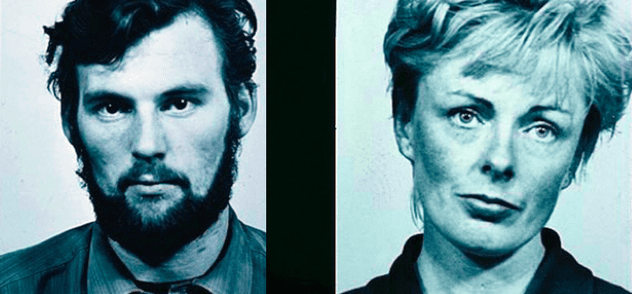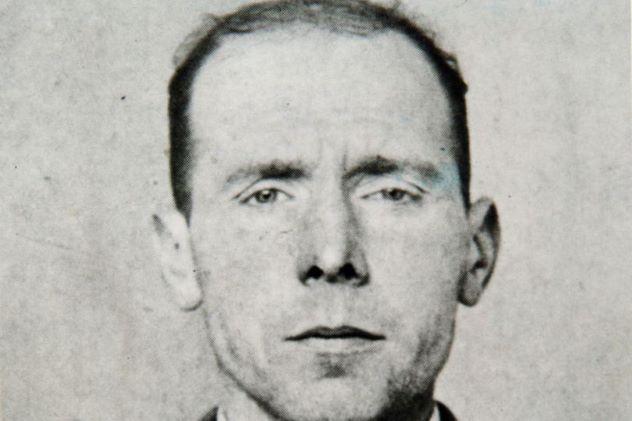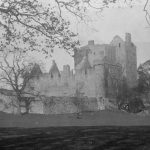 Technology
Technology  Technology
Technology  Humans
Humans 10 Everyday Human Behaviors That Are Actually Survival Instincts
 Animals
Animals 10 Animals That Humiliated and Harmed Historical Leaders
 History
History 10 Most Influential Protests in Modern History
 Creepy
Creepy 10 More Representations of Death from Myth, Legend, and Folktale
 Technology
Technology 10 Scientific Breakthroughs of 2025 That’ll Change Everything
 Our World
Our World 10 Ways Icelandic Culture Makes Other Countries Look Boring
 Misconceptions
Misconceptions 10 Common Misconceptions About the Victorian Era
 Mysteries
Mysteries 10 Strange Unexplained Mysteries of 2025
 Miscellaneous
Miscellaneous 10 of History’s Most Bell-Ringing Finishing Moves
 Technology
Technology Top 10 Everyday Tech Buzzwords That Hide a Darker Past
 Humans
Humans 10 Everyday Human Behaviors That Are Actually Survival Instincts
 Animals
Animals 10 Animals That Humiliated and Harmed Historical Leaders
Who's Behind Listverse?

Jamie Frater
Head Editor
Jamie founded Listverse due to an insatiable desire to share fascinating, obscure, and bizarre facts. He has been a guest speaker on numerous national radio and television stations and is a five time published author.
More About Us History
History 10 Most Influential Protests in Modern History
 Creepy
Creepy 10 More Representations of Death from Myth, Legend, and Folktale
 Technology
Technology 10 Scientific Breakthroughs of 2025 That’ll Change Everything
 Our World
Our World 10 Ways Icelandic Culture Makes Other Countries Look Boring
 Misconceptions
Misconceptions 10 Common Misconceptions About the Victorian Era
 Mysteries
Mysteries 10 Strange Unexplained Mysteries of 2025
 Miscellaneous
Miscellaneous 10 of History’s Most Bell-Ringing Finishing Moves
Ten of Scotland’s Most Infamous Murder Cases
One killer shoved his new bride off a cliff in Edinburgh for the insurance. Another shot two families in their beds as he burgled their homes. A third was publically hanged for killing a neighbor she’d quarreled with over some allegedly stolen wood. Scotland has had its fair share of gruesome murders, and we’ve compiled this grim gallery describing ten of them, the earliest dating from 1696 and the latest from 1977.
Related: Top 10 Cases That Baffled Scotland Yard
10 Robert Balfour

Robert Balfour became the fifth Lord Balfour of Burleigh on the death of his father, Robert Balfour, in 1713. As a young man, this fifth Balfour did something that his aristocratic parents—his mother was Lady Margaret Melville—took great exception to. He fell in love with a woman below him in the rigid Scottish social hierarchy of the day. Balfour’s parent’s reacted by sending him abroad.
Before his departure, Balfour told his young paramour that if she married in his absence, he would murder her spouse. Apparently undeterred by this chilling threat, the young woman wed a school teacher called Henry Stenhouse. When Balfour arrived back in Scotland in 1707, he sought out Stenhouse, stabbing him in the shoulder. The wound killed the unfortunate man a couple of weeks later.
Tried and found guilty of murder in 1709, Balfour was sentenced to beheading. But dressing up in his sister’s clothes, Balfour managed to escape his Edinburgh prison cell and hung on to his head until his death in 1757.[1]
9 Harry Burnett
Harry Burnett was just 21 years old in 1963 when he fell in love with Margaret Guyan, a woman four years his senior who worked at the same fish-curing company as him in the city of Aberdeen. Margaret was married with two children, having wed Thomas Guyan in 1957. But her husband was a mariner who was often away from home, and according to a BBC report, their marriage was “loveless.”
Guyan went so far as to move into Burnett’s Aberdeen home, her youngest child in tow. Burnett turned out to be a controlling, jealous type who kept his lover under lock and key. Unsurprisingly, Guyan found this intolerable and decided to return to her apparently forgiving husband.
Infuriated, Burnett got hold of a shotgun, tracked down Thomas Guyan, and by his own account, “gave him both barrels.” Thomas died on the spot. At his trial, Burnett pleaded insanity but was found guilty of murder. Burnett was hung, the last man to be executed in Scotland before capital punishment was abolished throughout the UK.[2]
8 Sheila Garvie and Brian Tevendale

The trial of Sheila Garvie and Brian Tevendale for the murder of Sheila’s husband, Max, caused an absolute sensation in Scotland in 1968. The country then was still in the grip of Protestant conservatives when it came to social mores. So when evidence in the trial detailed bizarre sexual practices, orgies, and nudism, the Scottish public was both horrified and fascinated. Long lines for a place in the public gallery at Aberdeen’s High Court on trial days formed as early as 3:30 am.
Brian Tevendale and Sheila Garvie had been conducting an affair that she alleged had started at the instigation of her husband. In turn, Max was having an affair with Tevendale’s sister. At the trial, the prosecution said that Mrs. Garvie had conspired with Tevendale to murder Mr. Garvie. She had opened the door of the farmhouse where the couple lived, allowing Tevendale access. She’d then given her lover one of her husband’s rifles, and he’d shot Max as he lay in bed. Tevendale and Garvie were found guilty and sentenced to life in prison. Both were released in 1978, with Tevendale living on until 2003 and Garvie until 2014.[3]
7 Mary Timney
It’s January 1862, and a man named Lockhart Hannah has just come across a horrific scene. His sister Anna lies dead in her countryside home in the farmstead of Carsphad in the southwestern Scottish region of Dumfries. Anna had been brutally beaten and was not long for this world when her brother found her. Two bloodied weapons lay by her body: a knife and an iron bar.
It wasn’t long before a prime suspect was identified. She was Mary Timney, Anna’s next-door neighbor. The two had a prior history of quarreling. Even more damningly, eyewitnesses who’d seen Timney in bloodstained clothing came forward. At the trial, it emerged that Anna had accused Timney of stealing some wood. The jury found Timney guilty after just 30 minutes of deliberation.
In somber tones, Judge Lord Deas pronounced that the murderer should be “hanged by the neck upon a gibbet till she be dead.” The sentence was to be carried out in public in the town of Dumfries in 1862 despite a relentless campaign for mercy. Mary Timney was the last woman to be publically hanged in Scotland.[4]
6 Patrick Carraher

In the 1930s, Glasgow was riven by gang conflict. The names of the gangs—the Norman Conks, the Bingo Boys, the Tongs, the Billy Boys, and San Toy—might have had a certain devilish appeal, but the violence was all too real. Some of the gangs were actually highly organized and even dabbled in politics. Worryingly, at one point, the Billy Boys opened a branch of the British Union of Fascists in Glasgow, a Hitlerite party led by renegade politician Sir Oswald Mosley.
One of the most notorious and violent of the Glasgow gangsters was a certain Patrick Carraher. Although from a respectable blue-collar family, Carraher took to a life of crime from an early age, first locked up when he was just 14. It wasn’t just other gang members who fell victim to his slashing and stabbing—innocent bystanders were also on the receiving end of the violence.
But Carraher finally went too far when he killed a soldier, John Gordon, in a brawl. At the subsequent murder trial, Carraher tried a defense of psychopathy. It didn’t wash, and Carraher was hung in Glasgow’s Barlinnie Prison in 1946. He was 40 years old, and he’d spent some 20 of those behind bars.[5]
5 Donald Forbes

When Donald Forbes was convicted of drug offenses in 2003 at the age of 68, the court sentenced him to 12 years in jail. He’d already spent 40 years of his life behind bars. But it was the crimes Forbes committed before his final spell in prison that were truly shocking.
In 1958, Forbes robbed a fish processing plant at Granton, just outside of Edinburgh. A nightwatchman had resisted, and Forbes whacked him on the head with a bottle, killing the man. For that atrocity, Forbes was condemned to death at Edinburgh’s High Court. But after a public campaign, the 23-year-old murderer’s sentence was commuted to life in prison.
After serving less than a dozen years in jail, Forbes was released in 1970. Just seven weeks later, he killed again, stabbing a man to death in a pub brawl. After being found guilty, the double-murderer was handed a second life sentence. He walked free from that in 1999. As we’ve seen, four years later, he was convicted of drug dealing. This time, he really did spend the rest of his life in prison, dying at the age of 73 in 2008.[6]
4 Archibald Hall
Glasgow-born Archibald Hall was a butler and a notorious serial killer. His first murder came in Dumfriesshire in southern Scotland in 1975 when Hall shot a former lover named David Wright in the head. Initially getting away with that, Hall moved to London, where he butlered for the Scott-Elliot family.
In December 1977, Hall boasted to barmaid Mary Coggle and petty criminal Michael Kitto that he planned to rob his employers. He then took his pals to the Scott-Elliot’s Kensington apartment. But Mrs. Scott-Elliot turned up unexpectedly and was killed, probably smothered. The three crooks then put her body in the trunk of the Scott-Elliot’s car. They drugged Mr. Scott-Elliot, shoved him in the car, too, and drove to Scotland. There they buried Mrs. Scott-Elliot and killed her husband. Then Hall and Kitto killed Coggle.
Finally, with Kitto’s help, Hall killed his own half-brother Donald Hall, apparently suspecting him of sex crimes. The two subdued Donald with chloroform before drowning him in a bath. The police caught the murderous pair near the Scottish seaside town of North Berwick as they prepared to get rid of Donald’s body. Both men were given four life sentences each. Hall died in prison in 2002, aged 78.[7]
3 Captain Kidd
William Kidd was probably born in the Scottish city of Dundee in 1654, although there is some controversy about the facts. In any case, like so many Scots, Kidd wasn’t content to see out his days in his native land, and by the late 1680s, he was a ship’s skipper sailing from New York City.
During the 1690s, Kidd ran as a privateer and fought for the English against the French, protecting merchant ships traveling to and from America. He also undertook English government commissions to root out pirates in the Caribbean. In 1696, Kidd sailed for the Indian Ocean aboard the Adventure Galley to track and destroy pirate ships. But his crew grew mutinous, and in a fit of rage, he hurled a heavy bucket at his gunner’s head, killing him.
A victim of changing political winds, Kidd himself was now accused of being a pirate because of his privateering. He was also accused of his gunner’s murder. Arrested in Boston, Kidd was sent to London for trial. In 1701, Kidd was found guilty of piracy and murder. He was hung at Wapping on the Thames, and his body was suspended in chains by the river.[8]
2 Ernest Dumoulin

Speaking to a newspaper in 2006, Ernest Dumoulin cast his mind back to an October evening in 1972, when he had been just 21. “It was the darkest night of my life. I held Helga in my arms and kissed her passionately. I wanted her to feel that I loved her above everything else,” Dumoulin recalled. Perhaps he really did love his 18-year-old German bride, Helga Konrad, but after that romantic clinch, he pushed her off a cliff so that she fell 100 feet (30 meters) to her death.
The steep cliff in question was a section of the Salisbury Crags, an impressive geological feature that looms over Edinburgh. At first, Dumoulin claimed that Helga’s death, which had come just days after the two had wed, had been a horrible accident.
But the landlady of the room the couple was staying in found a receipt for a life insurance policy for a huge sum, equivalent to more than $8 million today. The policy was to cover Helga. Dumoulin was tried for his young bride’s murder and found guilty. After serving 16 years in a Scottish jail, Dumoulin moved to Germany, where he apparently became a pastor.[9]
1 Peter Manuel
Born in 1927, Peter Manuel earned his first prison sentence at just the age of 15 for a viciously violent burglary. Manuel’s crimes turned deadly in 1956, a few years after he’d been released from one of his regular spells in jail. He killed 17-year-old Anne Kneilands and dumped her body on a golf course in the Scottish town of East Kilbride. Initially, he escaped justice for that killing thanks to an alibi furnished by his father.
Later in 1956, Manuel shot sisters Marion Watt and Margaret Brown, plus Marion’s daughter Vivienne in their home. Next, he killed 17-year-old Isabelle Cooke and followed that with another triple murder during a burglary. Peter Smart, his wife Doris, and their 11-year-old son Michael all died at the hands of Manuel, shot in their beds. Finally arrested early in 1958, Manuel was tried for eight murders at Glasgow’s High Court. Sentenced to death, he was hung at Barlinnie Prison in July, his body committed to an unmarked grave on the grounds of the jail.[10]








